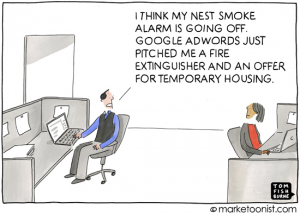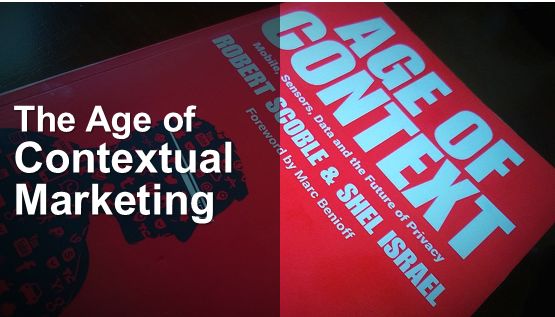What is the future of technology? How will technology impact your business and how does it impact marketing?
The preceding two questions are very important. Companies that are not able to adapt to rapid changes in technology are left behind to die. Examples abound, even innovative companies that were ahead of their times in their use of technology such as Blackberry, Blockbuster, Circuit City, among others. Most business executives recognize the need to evolve, as do most marketers. After all, that’s why I named this blog the Adaptive Marketer.
My oldest daughter just turned 14. I have had to explain rotary phones, cassette tapes, film cameras and typewriters to her. Kids born today will have to ask their parents to explain what a music CD and a DVD are. The evolution of these technologies has created and destroyed entire industries who failed to foresee the importance and impact of these new technologies. Any business person should be asking: What is the next revolution? Where are things going? How will these changes affect my business?
I found many answers in The Age of Context by the dynamic duo: futurist & technology blogger Robert Scoble and writer and storyteller & writer Shel Israel.
It was only a few years ago (2001) that I was on stage showing the first Java-powered smartphones at JavaOne in San Francisco. It was during a session on mobile development where we introduced the first mobile development kits to the world. A Motorola A388 and a Nextel 85s, which had a black and white screen that supported 5 lines of text, featured 300 kilobytes of memory and a processor fast enough launch a chess game in only 4 or 5 minutes.
This was the beginning of a revolution that has transformed our world so quickly that it is hard to imagine how our world worked before the iPhone, it is hard to conceive a successful website without mobile support and hard to find a place in the world where most people are not holding a smartphone in their hand.
“Change is inevitable, and the disruption it causes brings both inconvenience and opportunity.” Shel and Robert write in the first chapter. This is very much in line with Peter Drucker’s thoughts captured decades ago in his book Innovation and Entrepreneurship “And it is change that always provides the opportunity for the new and different. Systematic innovation therefore consists in the purposeful and organized search for changes, and in the systematic analysis of the opportunities such changes might offer for economic or social innovation.”
To be honest, before reading The Age of Context, I was skeptical. After all, there are plenty of technology predictions out there and analysts talking about the impact of social, big data, cloud and other technologies. The Age of Context is different. It’s real. It is full of practical examples.
The book talks about five technologies, or ‘forces’, that are changing the world today: sensors, mobile, data, social and location. “Forward thinking business leaders and tech evangelists are already using these forces to prosper, while simultaneously making their customers and followers happier, and technologists are coming up with new contextual tools, toys and services at breathtaking speed”
As Drucker wrote “This defines entrepreneur and entrepreneurship – the entrepreneur always searches for change, responds to it, and exploits it as an opportunity.”
The Internet of Things
In this case, these five forces are working together to form a new industry, a new concept that is commonly called The Internet of Things. Where even the simplest products can be enabled with sensors to share data and location to provide information beyond what we could have imagined a couple years ago.
The Age of Context is full of examples of devices that take advantage of one or more of these five forces to transform our world. Anyone who knows Robert Scoble could guess the fist one is Google Glass. but there are many more examples: from Uber to activity tracking bands to cars that understand where you are going.
The Internet of Things can go from the somewhat ridiculous (a bluetooth toothbrush that monitors your dental hygiene) to the practical: new Windows Phones know when you are in your car and can be set to ignore calls or automatically reply to callers with a text message letting them know you are driving.

What are the implications for Marketers? The Age of Contextual Marketing
The most important of the five forces for marketers is context. You can think about sensors, data and location as sources of information that provide context to deliver a more relevant experience to consumers. In marketing, content is King but context rules. Context rules because it makes the experience relevant.
Relevance is especially important in this age when consumers are unsubscribing, skipping commercials and adding their number to the ‘do not call’ list. They don’t want more marketing, but they appreciate useful information. Providing useful information is the key to content marketing. Information and content become useful when they apply to the context in which we exist, when it applies to the specific problems we are facing or situations we live in. Location, sensors, and other data can help us provide the context to determine what is useful for someone at any given time.
Marketers have strived to provide personalized experiences for over a decade, especially online, often with limited success. Even Amazon, the world’s largest retailer, who centered their strategy around personalization for years, struggles to differentiate between Eating the Big Fish (a marketing book) and an interest for fishing as a sport (is it really a sport? You spend most of the time sitting doing exactly nothing…). Amazon struggles to differentiate between a one-time gift purchase and an interest.
Marketers need to be smart about understanding the differences between personalization (providing content and experiences based on a persona that represents a customer segment), individualization (based on an individual’s unique needs), customization (based on a customer’s explicit preferences) and contextualization (based on an individual’s context) – and choosing the right approach between these based on their products, industry and customers.
How is context important for customer experiences? Contextual Marketing is not abstract. Here is a post written 5 years ago about how context, not a frequency policy, should guide communication frequency. Imagine a world-class performer playing with a million-dollar Stradivari violin built in the 1700s. The maestro starts playing some of the most beautiful music ever. And yet, he is completely ignored. Why?
He was ignored because of the context. He was playing in a subway station with a container to accept donations. As a social experiment, Joshua Bell, a violin prodigy, played in a subway station in Washington DC (check the full story). It was the context that compelled people to keep walking by and completely ignore the musician. The same people that walked by would pay more than $100 to hear the same musician at a concert hall.
Contextual marketing is not new. Since 2003, Mohan Sawhney, professor at the Kellogg School of Management , has been educating us on the concept. It is the evolution of technology, and the practical viability or maturity of the five forces described by Israel and Scoble that make contextual marketing a critical concept for marketers today.
If sensors, data and location provide context, what about the other two forces, social and mobile? They are of course an essential part of the experience. Everything marketers do should have a social and a mobile angle. They are not ‘things’ or buzzwords anymore, they are essential parts of marketing communications and human interaction. Companies should stop hiring social marketers and start making sure all marketers understand social media and make social media an element of every marketing activity. No website today is relevant unless it offers a mobile experience too.
Data fuels context. But data needs to be personal, which brings up the concept of data collection and privacy. Big Data tempts us to collect all the data we can get our hands on. However, marketers should only collect the data that is relevant to the interaction with customers. Focus on capturing the data that you can act upon and no more. This applies to surveys, sensors and data analysis.
Privacy is probably a bigger challenge. It has been said that trust is the new currency. When customers trust us with their data, it is our responsibility to respect their privacy and to protect their security. This has technological implications, of course, but we can start by simply giving customers control of what data they share, what we collect, and how we can use it. Be transparent. Let your customers, and not corporate policies, drive your data practices.
The week I am writing this post there are news of Nike disbanding their Fuelband team and of Scoble finding controversy on his statements the use of Google Glass in public, precisely because of the privacy concerns of walking around with a camera on your face. These are not indicators of the internet of things being a fad. They are part of a natural maturity process where people become accustomed to new realities while companies adjust their products, business models and practices to a new world.
Welcome to the age of context.


